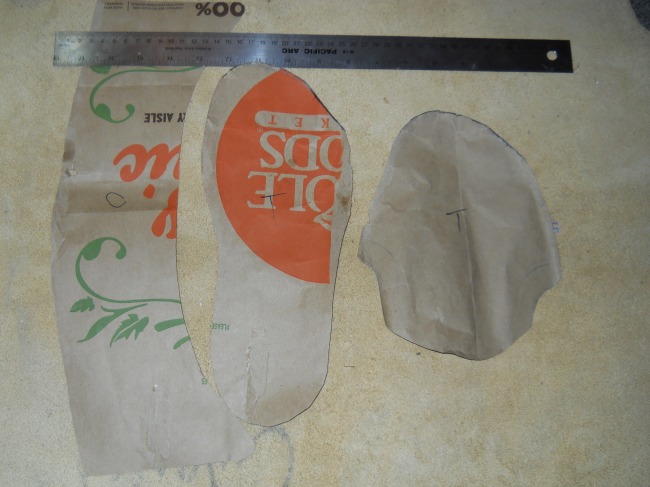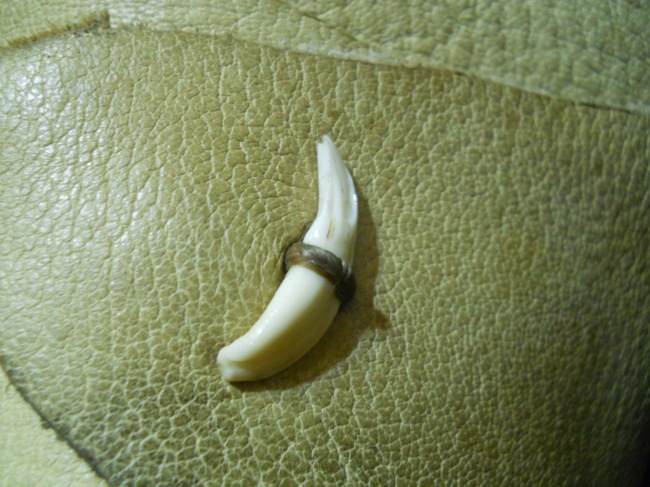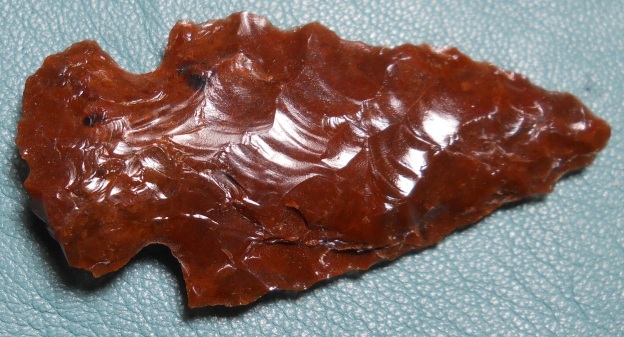1) First, trace your foot on some paper to make the pattern for the sole. You should leave a centimeter or so space between your foot and the edge of the pattern:


2) Trace these other patterns based on the size of the sole pattern. Analyze the below photos to determine the relative shapes / sizes. See step the third photo below to better size the tongue pattern (pattern on right side). Basically it should cover the top of your foot and its sides wrap around to meet the edges of the sole pattern with sufficient space (~ 1cm) to stitch.



4) Check the patterns have the right size and shape by lightly taping the edges to form a model of the moccasin.


5) After correcting for any size / shape problems revealed by the model, trace the patterns onto your leather (or other material of choice). Be sure to flip the patterns after tracing one side to make a mirror-image set of patterns for left and right foot. Mark each with an L or R to keep track of which go together.
Leather is usually irregularly shaped, so try different arrangements to fit all the patterns with as little waste as possible (in case you want a pair of replacement soles or for other uses).
Here, I used bison leather since it is very thick. In retrospect, the sole wore through rather sooner than I expected. Perhaps the wide grain size made for a more “loose” matrix of collagen in the leather, allowing it to wear sooner. I did wear them every day on concrete, so that’s another issue. I’ve read the Apache used rawhide soles to extend wear life. I may try this next. Fortunately the soles are easy to replace.


6) Put together the first moccasin, putting the inside facing out, and holding the edges (to be stitched) with pins.


7) Stitch the seams. Here I used artificial sinew divided in half (since it was then doubled around the pin eyehole, the stitches ended up being the same thickness as the original strand). To save a lot of effort, use a glovers needle (these are for leather and have really sharp tips with a triangular cross section). I used a whipstitch (aka lazy stitch), and used a sweet potato to put under the seam where I was pushing the needle in, so it easily went through the other side. Bison leather is super thick, so I had to use some pliers to pull the needle the rest of the way through from the other side.
Important note!! The below photo is incorrectly sewn where the back meets the tongue. It should be the opposite, with the tongue closest to the outside, so when you turn it inside out when you finish, you want the backs to be closest to the outside (see complete moccasin). I had to cut and resew the stitches on the below photo!

8) The below photos show the complete, correctly sewn, moccasins before and after being turned inside-out.


9) The completed moccasin! For this design (of my own invention), you will need a button of some sort to hold the sides that go over the tongue together. I used the canines of a grey fox skull I found for this. Except for thorough cleaning, you actually don’t need to unbutton and re-button it to put on the moccasin. Simply push down the heel, slide your foot in, then pull the heel up. They still fit very well and are extremely comfortable and good for running or anything else (except maybe wet weather which speeds the wear on the soles).
So the button can be difficult to unbutton or you could simply sew it permanently shut. I show some close-ups of the button I used below. The long cylindrical shape is cool since you can twist it and insert it into a small hole by the end. To get the sinew to stay wrapped on the canines, I had to file a shallow trench around the canine which the sinew could sit inside, then I tied it really tightly. Other button ideas I had was using shells, a strong twig, or a slice of a maple wood twig for a more conventionally-shaped button.
Note the below photos are after several months of wearing these all day every day, mostly on concrete, and never having washed them. They are easy to wash; just use warm water and soap to scrub by hand then let them air-dry.



























